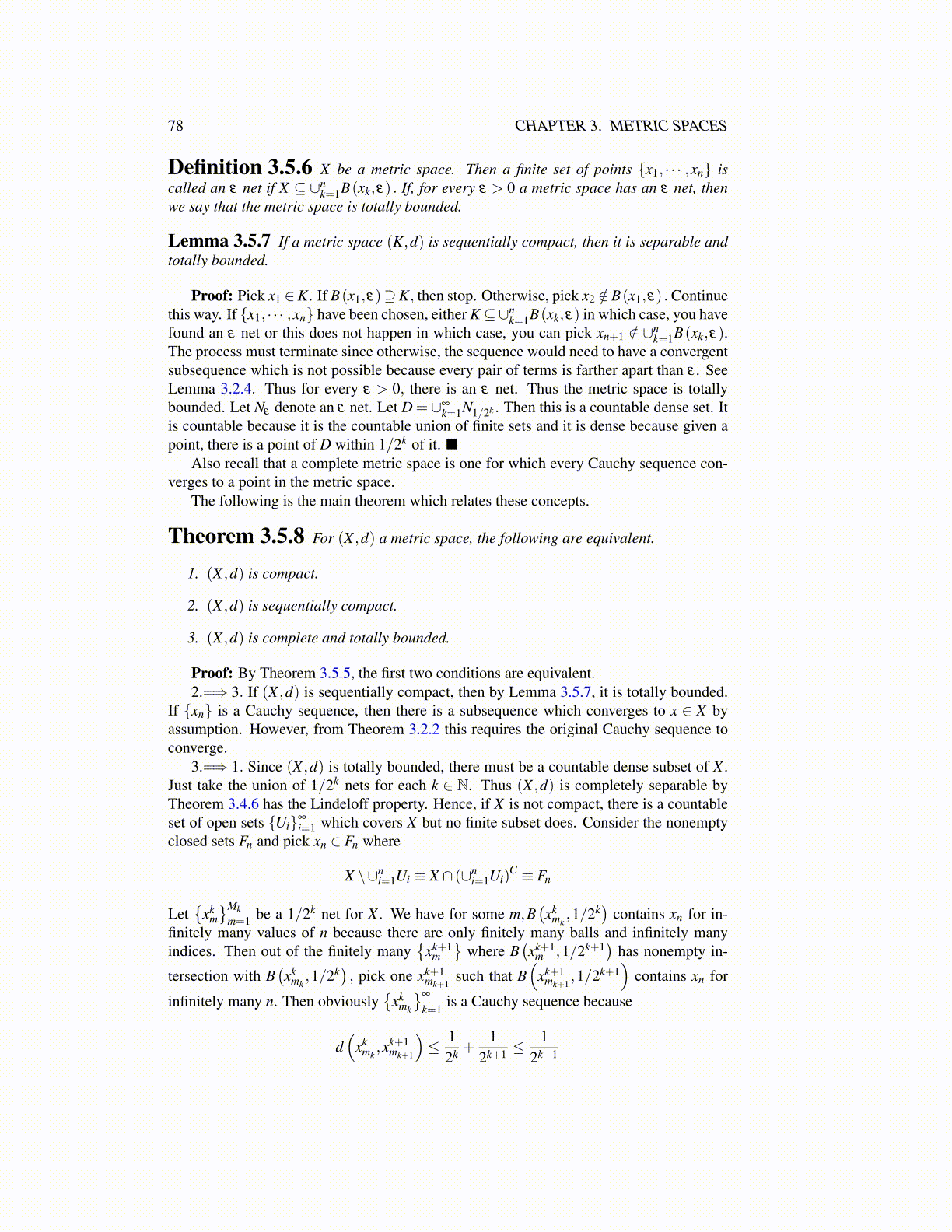
78 CHAPTER 3. METRIC SPACES
Definition 3.5.6 X be a metric space. Then a finite set of points {x1, · · · ,xn} iscalled an ε net if X ⊆ ∪n
k=1B(xk,ε) . If, for every ε > 0 a metric space has an ε net, thenwe say that the metric space is totally bounded.
Lemma 3.5.7 If a metric space (K,d) is sequentially compact, then it is separable andtotally bounded.
Proof: Pick x1 ∈K. If B(x1,ε)⊇K, then stop. Otherwise, pick x2 /∈B(x1,ε) . Continuethis way. If {x1, · · · ,xn} have been chosen, either K⊆∪n
k=1B(xk,ε) in which case, you havefound an ε net or this does not happen in which case, you can pick xn+1 /∈ ∪n
k=1B(xk,ε).The process must terminate since otherwise, the sequence would need to have a convergentsubsequence which is not possible because every pair of terms is farther apart than ε . SeeLemma 3.2.4. Thus for every ε > 0, there is an ε net. Thus the metric space is totallybounded. Let Nε denote an ε net. Let D = ∪∞
k=1N1/2k . Then this is a countable dense set. Itis countable because it is the countable union of finite sets and it is dense because given apoint, there is a point of D within 1/2k of it. ■
Also recall that a complete metric space is one for which every Cauchy sequence con-verges to a point in the metric space.
The following is the main theorem which relates these concepts.
Theorem 3.5.8 For (X ,d) a metric space, the following are equivalent.
1. (X ,d) is compact.
2. (X ,d) is sequentially compact.
3. (X ,d) is complete and totally bounded.
Proof: By Theorem 3.5.5, the first two conditions are equivalent.2.=⇒ 3. If (X ,d) is sequentially compact, then by Lemma 3.5.7, it is totally bounded.
If {xn} is a Cauchy sequence, then there is a subsequence which converges to x ∈ X byassumption. However, from Theorem 3.2.2 this requires the original Cauchy sequence toconverge.
3.=⇒ 1. Since (X ,d) is totally bounded, there must be a countable dense subset of X .Just take the union of 1/2k nets for each k ∈ N. Thus (X ,d) is completely separable byTheorem 3.4.6 has the Lindeloff property. Hence, if X is not compact, there is a countableset of open sets {Ui}∞
i=1 which covers X but no finite subset does. Consider the nonemptyclosed sets Fn and pick xn ∈ Fn where
X \∪ni=1Ui ≡ X ∩ (∪n
i=1Ui)C ≡ Fn
Let{
xkm}Mk
m=1 be a 1/2k net for X . We have for some m,B(xk
mk,1/2k
)contains xn for in-
finitely many values of n because there are only finitely many balls and infinitely manyindices. Then out of the finitely many
{xk+1
m}
where B(xk+1
m ,1/2k+1)
has nonempty in-
tersection with B(xk
mk,1/2k
), pick one xk+1
mk+1such that B
(xk+1
mk+1,1/2k+1
)contains xn for
infinitely many n. Then obviously{
xkmk
}∞
k=1is a Cauchy sequence because
d(
xkmk,xk+1
mk+1
)≤ 1
2k +1
2k+1 ≤1
2k−1